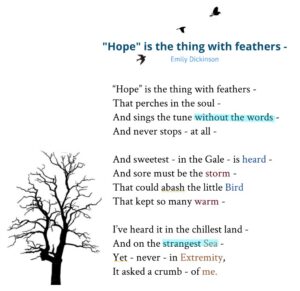Compiled by: Rycha Susanto
Hello, everyone.
World Book Day is celebrated this April. This year’s theme is ‘Share a Story’.
Did you know that long before there were printed books, people would tell stories through poems?
And not only stories, you can express your mood, thoughts and feelings with rhythm, rhyme, repetition and vivid language. Below is one of my favorite poems by Emily Dickinson.
Let’s read the poem below, and be prepared to be carried away.

Ever heard of Emily Dickinson? She wrote poetry in the 1850 and 1860s and she is considered to be one of the best American poets. Emily uses her imagination and experiments with her poetry. She is important for she writes about new subjects: science, religion, home life, loss and death. The voice in her poetry is that of a disobedient and rebellious child. She began writing in a time of educational freedom for young girls. Before this, girls could not go to school. Her work was not published in her lifetime but 4 years after her death. Her work is widely read and it is studied in schools and at universities.
Now, let’s start reading between the lines.
In stanza one, the first word is given special emphasis with speech marks (“) as if the poet wants to define the word “Hope”. The poet eventually uses metaphor to do so. This “hope” bird “perches” in the soul, showing that the soul itself is hope’s home. Hope then, is directly linked with human spirit, where it sings without ever stopping. The song is special for there are no words, no diction for anyone to understand rationally. The song is endless. Note the double dash emphasis on – at all – and the stanza break which brings extra attention to these two little words.
In stanza two, hope is always singing as we know from the first stanza but it sings the sweetest when the going gets rough; when the Gale (a very strong wind) starts to blow. So, when life is hard and things are thrown at us, the pressure relentless, there is Hope, singing through the chaos and mayhem. In other words, hope shows its importance in times of adversity and seems to guide people through that adversity. Hope gives so many (people) warmth and the strength to carry on, and it’s at its most useful when circumstances are at their worst.
In stanza three, the personal pronoun “I” appears for the first time, indicating a personal connection to this subject perhaps? The speaker has heard the bird during the hardest, coldest times, when emotions are churning and life surreal. And at those times, hopes are always there: in the chillest land and in the strangest sea a person’s emotion might be. Hope gives us much but never asks for a crumb in return; even when things are at extreme adversity. It can give us strength to carry on in the most adverse of conditions. Its voice can be heard, despite the noise at the height of the storm. People just have to listen to the “little Bird” singing its tune.
Writers and poets use literary devices to make their poetry comprehensible, beautiful and rich. Emily Dickinson also has used some literary devices to express her spiritual thoughts.
Can you spot on some devices used here?
Literary Device Analysis
Alliteration: Peter Piper picked a peck of pickled pepper.
The repetition of the same consonant sounds occurring close together in a row to create musical effects such as the repetition of /h/ sound in “we have heard it in the chilliest land” where this sound has created a musical quality in the line.
Metaphor: My heart is a lonely hunter.
There is one extended metaphor in the poem. Dickenson has compared hope with “feathers”/“bird” which shows how it sings and gives courage to the spirit of a person.
Personification: The brutal wind bullied the trees.
When an inanimate object is given human characteristics or qualities, it is personified. In the first stanza, Dickenson considers hoping a preacher that keeps on preaching and never stops. It sings its silent song in the hearts of the men to fill them with spiritual power. In other words, she has personified hope in this poem.
Imagery: Earthy musk of damp moss filled my nostrils.
Imagery is used to make the readers perceive things through five senses. It helps them to create a mental picture of the objects described. The poet has used images for the sense of sight such as, “bird”, “feathers”, “storm”, “land” and “sea.”
Sources and Further Reading
- https://www.lottie.com/blogs/strong-women/emily-dickinson-biography-for-kids
- https://literarydevices.net/hope-is-the-thing-with-feathers/
- https://www.sparknotes.com/poetry/dickinson/section2/
- https://www.litcharts.com/poetry/emily-dickinson/hope-is-the-thing-with-feathers
- https://owlcation.com/humanities/Analysis-of-Poem-Hope-Is-The-Thing-With-Feathers-by-Emily-Dickinson
- https://prezi.com/344evb0ezy1z/hope-is-the-thing-with-feathers-/
- https://interestingliterature.com/2016/02/a-short-analysis-of-emily-dickinsons-hope-is-the-thing-with-feathers/
- https://poemanalysis.com/emily-dickinson/hope-is-the-thing-with-feathers/
- https://academic.brooklyn.cuny.edu/english/melani/cs6/hope.html



